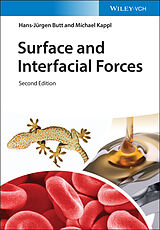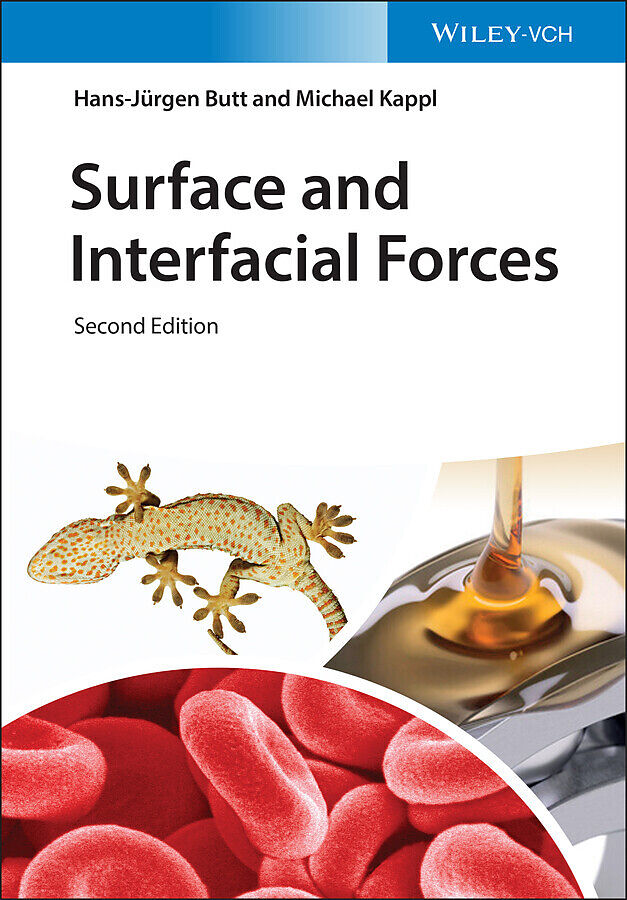Surface and Interfacial Forces
Format:
E-Book (pdf)
EAN:
9783527804344
Genre:
Atomphysik, Kernphysik
Autor:
Hans-Jürgen Butt, Michael Kappl
Herausgeber:
Wiley-VCH
Anzahl Seiten:
456
Erscheinungsdatum:
26.03.2018
A general introduction to surface and interfacial forces, perfectly combining theoretical concepts, experimental techniques and practical applications. In this completely updated edition all the chapters have been thoroughly revised and extended to cover new developments and approaches with around 15% new content. A large part of the book is devoted to surface forces between solid surfaces in liquid media, and while a basic knowledge of colloid and interface science is helpful, it is not essential since all important concepts are explained and the theoretical concepts can be understood with an intermediate knowledge of mathematics. A number of exercises with solutions and the end-of-chapter summaries of the most important equations, facts and phenomena serve as additional tools to strengthen the acquired knowledge and allow for self-study. The result is a readily accessible text that helps to foster an understanding of the intricacies of this highly relevant topic.
Autorentext
Hans-Jürgen Butt studied physics in Hamburg and Göttingen, Germany. Then he went to the Max-Planck-Institute of Biophysics in Frankfurt. After receiving his PhD in 1989 he went as a post-doc to Santa Barbara, California, using the newly developed atomic force microscope. From 199095 he spent as a researcher back in Germany at the Max-Planck-Institute for Biophysics. In 1996 he became associate professor for physical chemistry at the University Mainz, three years later full professor at the University of Siegen. Two years later he joined the Max-Planck-Institute of Polymer Research in Mainz and became director for Experimental Physics. Michael Kappl received his PhD thesis from the Max-Planck-Institute of Biophysics in Frankfurt and worked at the University of Mainz and Siegen. Since 2002 he is group leader at the MPIP, working in the fields of surface forces, wetting and characterization of mechanical properties on the micro- and nanoscale.
Inhalt
Preface xi List of Symbols xiii 1 Introduction 1 2 ExperimentalMethods 5 2.1 Surface Forces Apparatus 6 2.1.1 Mica 8 2.1.2 Multiple Beam Interferometry 9 2.1.3 Friction Force Measurements 12 2.1.4 Surface Modification 13 2.2 Atomic Force Microscope 13 2.2.1 Force Measurements with the AFM 14 2.2.2 AFM Cantilevers 16 2.2.3 Calibration of the Spring Constant 18 2.2.4 Microfabricated Tips and Colloidal Probes 21 2.2.5 Friction Forces 22 2.2.6 Force Maps 24 2.2.7 Dynamic Modes 25 2.3 Optical Tweezers 26 2.3.1 Calibration 30 2.3.2 Multiple Traps 32 2.4 Total Internal Reflection Microscopy 33 2.5 Magnetic Tweezers 36 2.6 Summary 40 2.7 Exercises 41 3 van derWaals Forces 43 3.1 van derWaals Forces between Molecules 43 3.1.1 Coulomb Interaction 43 3.1.2 MonopoleDipole Interaction 44 3.1.3 DipoleDipole Interaction 47 3.1.3.1 Keesom Interaction 48 3.1.3.2 Debye Interaction 49 3.1.3.3 London Dispersion Interaction 50 3.2 The van derWaals Force between Macroscopic Solids 52 3.2.1 Microscopic or Hamaker Approach 52 3.2.2 Macroscopic Calculation: Lifshitz Theory 57 3.2.3 Hamaker Constants 64 3.2.3.1 Calculation of Hamaker Constants 64 3.2.3.2 Combining Relations for Hamaker Constants 70 3.2.3.3 Table of Hamakar Constants 71 3.2.4 Surface Energy and Hamaker Constant 71 3.3 The Derjaguin Approximation 78 3.3.1 The General Equation 78 3.3.2 van derWaals Forces for Different Geometries 81 3.4 Retarded van derWaals Forces 82 3.4.1 Screening of van derWaals Forces in Electrolytes 84 3.5 Measurement of van derWaals Forces 85 3.6 The Casimir Force 88 3.6.1 Casimir Forces between Metal Surfaces 88 3.6.1.1 The Effect of Temperature 90 3.6.1.2 Finite Conductivity of Real Metals 90 3.6.1.3 Surface Roughness 91 3.6.1.4 Casimir Force for Nontrivial Geometries 92 3.6.2 Measurements of Casmir Forces 92 3.6.3 Critical Casimir Force 94 3.7 Summary 97 3.8 Exercises 98 4 Electrostatic Double-Layer Forces 99 4.1 The Electric Double Layer 99 4.2 PoissonBoltzmann Theory of the Diffuse Double Layer 100 4.2.1 The PoissonBoltzmann Equation 100 4.2.2 Planar Surfaces 101 4.2.3 The Full One-Dimensional Case 104 4.2.4 The Electric Double Layer around a Sphere 106 4.2.5 The Grahame Equation 107 4.2.6 Capacity of the Diffuse Electric Double Layer 108 4.3 Beyond PoissonBoltzmann Theory 109 4.3.1 Limitations of the PoissonBoltzmann Theory 109 4.3.2 The Stern Layer 111 4.4 The Gibbs Energy of the Electric Double Layer 112 4.5 The Electrostatic Double-Layer Force 114 4.5.1 General Equations 115 4.5.2 Electrostatic Interaction between Two Identical Surfaces 117 4.5.3 Electrostatic Interaction between Different Surfaces 118 4.6 The DLVOTheory 120 4.7 Electrostatic Forces in Nonpolar Media 123 4.8 Summary 128 4.9 Exercises 129 5 Capillary Forces 131 5.1 Equation of Young and Laplace 132 5.2 Kelvin Equation 135 5.2.1 Capillary Condensation 137 5.3 Young's Equation 138 5.4 Capillary Forces Calculated with the Circular Approximation 139 5.4.1 Capillary Force between a Sphere and a Plane 140 5.4.2 Two Different Spheres 144 5.4.3 Other Geometries 146 5.4.4 Assumptions and Limits 148 5.5 Influence of Roughness 150 5.6 Kinetics of Capillary Bridge Formation and Rupture 152 5.7 Capillary Forces in ...

Leider konnten wir für diesen Artikel keine Preise ermitteln ...
billigbuch.ch sucht jetzt für Sie die besten Angebote ...
Die aktuellen Verkaufspreise von 3 Onlineshops werden in Realtime abgefragt.
Sie können das gewünschte Produkt anschliessend direkt beim Anbieter Ihrer Wahl bestellen.
Loading...
Die aktuellen Verkaufspreise von 3 Onlineshops werden in Realtime abgefragt.
Sie können das gewünschte Produkt anschliessend direkt beim Anbieter Ihrer Wahl bestellen.
| # | Onlineshop | Preis CHF | Versand CHF | Total CHF | ||
|---|---|---|---|---|---|---|
| 1 | Seller | 0.00 | 0.00 | 0.00 |
